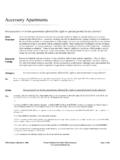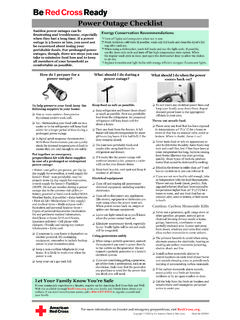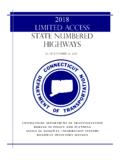Transcription of Road Width - Pioneer Institute
1 road Width Most subdivision regulations list the minimum required Width of pavement for all of the types of roads allowed in the municipality. In general, a travel lane is 9 10 feet, so the most narrow requirements are 18 20 feet of pavement. The average car or pickup is feet wide, and dump trucks and school buses are 7 feet. The rationale for roads wider than 20 feet is the need to accommodate parked cars and two-way traffic, as well as emergency road Width requirements are often listed in a section titled Street Design Standards, under the heading Width . The regulations often include a table that lists the required Width of pavement, right of way, and other standards for each road classification. A few of the regulations include the Width requirement in the definitions of the road classifications. The answer is sometimes found in diagrams in the appendix that label the dimensions of a cross section of road .
2 A few municipalities did not include a requirement for the Width of pavement; for some of these towns, the researcher asked the planner or building inspector what the Width requirement is for typical subdivision roads. Researcher selected the Width requirement for the road type selected for the question on typical subdivision is the Width of pavement required on typical subdivision roads (with 10-30 houses)?Issue OverviewResearch CodingThere is no standardized classification for types of roads. Each municipality labels and defines its road types in its own way. Typical names for residential subdivision roads include: minor, local, lane, residential, secondary, sub-collector, subsidiary, dead-end, cul-de-sac, court, feeder, intermediate and subdivision. The regulations sometimes define the type of road according to the number of houses on it, the number of expected vehicle trips per day, or both.
3 Some municipalities define subdivision roads as providing access to abutting lots or serving as a connection between such roads and collector roads. Some regulations do not include definitions for the road consistency, researchers coded typical subdivision as the street intended to serve 10-30 houses or 100-300 vehicle trips per day or closest equivalent category. If no house or traffic counts were listed, researchers chose the type used primarily to provide access to abutting lots , generally not intended to carry through traffic. If no classification of roads is listed, then the answer is various road types are specified in the regulations, which road type did the researcher select for "typical subdivision road "?Issue OverviewResearch CodingThe researcher selected the Width requirement for the most narrow road type listed in the regulations.
4 Courts, lanes and private roads are is the minimum Width of pavement required for the narrowest type of subdivision road ?Issue OverviewResearch CodingSubdivision regulations list the standard right of way boundaries for each type of road . The right of way" refers to areas dedicated to use by the public for pedestrian and vehicular travel, and can include the paved street, sidewalk, curb, gutter, median, grassy shoulder, etc. The requirement for typical subdivision rights of way is usually 40 50 ROW requirements are usually found in the section of the subdivision regulations titled Street Design Standards. For a few municipalities, the researcher calculated the ROW by adding the Width requirements for all of the ROW components pavements, sidewalks, curbs, is the Width of right of way required on typical subdivision roads (with 10-30 houses)?
5 Issue OverviewResearch Coding*Information collected in 2004 Pioneer Institute for Public Policy Research 1 of 186 AbingtonIf various road types are specified in the regulations, which road type did the researcher select for "typical subdivision road "?RESIDENTIAL/MINOR"Residential or Minor Streets: Existing or proposed streets which are used primarily for access to abutting properties for traffic at speeds of generally less than 30 "What is the Width of pavement required on typical subdivision roads (with 10-30 houses)?26 The Rules and Regulations Governing the Subdivision of Land in the Town of Abington, Ma, Section V(B)(2)(amended 2001) has a table which lists the type of street and minimum pavement Width . The table cannot be reproduced in this space."Residential or Minor Streets: Existing or proposed streets which are used primarily for access to abutting properties for traffic at speeds of generally less than 30 "The Width of pavement for residential/minor streets is 26 w/10 foot centerstrip (2 at 22 feet); Arterial w/o centerstrip (50 feet); Collector (36 feet); and Residential and Minor (26 feet)What is the minimum Width of pavement required for the narrowest type of subdivision road ?
6 26 Arterial w/10 foot centerstrip (2 at 22 feet); Arterial w/o centerstrip (50 feet); Collector (36 feet); and Residential and Minor (26 feet)What is the Width of right of way required on typical subdivision roads (with 10-30 houses)?52 The Width of right of way for residential/minor streets is 52 (80 feet); Collector (62 feet); and Residential or Minor (52 feet)ActonIf various road types are specified in the regulations, which road type did the researcher select for "typical subdivision road "?LOCALSECTION 2 GENERAL DEFINITIONS ARTERIAL STREET A STREET having an Average Daily Traffic volume of greater than 8000 vehicles per day. For proposed STREETS, the projected Average Daily Traffic volume shall be based on maximum potential build-out of all LOTS being accessed by said STREET, plus projected future through traffic volumes as deemed reasonable and realistic by the STREET A STREET having an Average Daily Traffic volume of greater than 2000 and up to and including 8000 vehicle trips per day.
7 For proposed STREETS, the projected Average Daily Traffic volume shall be based on maximum potential build-out of all LOTS being accessed by said STREET, plus projected future through traffic volumes as deemed reasonable and realistic by the STREETS LOCAL STREETS open at one end only with special provisions for turning STREETS LOCAL STREETS open at one end only without STREET A STREET having an Average Daily Traffic volume of 2000 or fewer vehicles per day. For proposed STREETS, the projected Average Daily Traffic volume shall be based on maximum potential build-out of all LOTS being accessed by said STREET, plus projected future through traffic volumes as deemed reasonable and realistic by the STREET A LOCAL STREET paralleling an ARTERIAL STREET or COLLECTOR STREET and specifically designed *Information collected in 2004 Pioneer Institute for Public Policy Research 2 of 186to separate land access from through ACCESS STREET A CUL-DE-SAC STREET; a DEAD-END STREET.
8 Or other STREET having only one terminus onto a THROUGH STREET and providing access to other CUL-DE-SAC STREETS, DEAD-END STREETS, or STREETS forming a closed loop or OR road A general term denoting a public or, private STREET for purposes of public vehicular and pedestrian travel, including the entire area within the STREET A STREET having, by itself or by means of other STREETS, a connection at both ends to the overall road system of the Town of Acton or of neighboring towns, so that each location on such STREET can be accessed through at least two alternative STREETS or combination of , PATH A general term denoting a public or private WAY for purposes of public non-vehicular travel, including the entire area within the right-of-way. Such WAYS or PATHS do not provide frontage.**Note: In survey received on 3/23/05, it was marked "LOCAL (use this because it is the standard that most roads are built under.)
9 What is the Width of pavement required on typical subdivision roads (with 10-30 houses)?20 Local Street: 20-24 feetCollector Street: 24-26 feetActon has three major categories of streets -- local, collector, and arterial. SECTION 8 DESIGN STANDARDS TABLE I HORIZONTAL DESIGN STANDARDS TABLE II VERTICAL DESIGN STANDARDS Local Street Collector StreetPavement Width 20**-24 feet 24-26 feet** For low intensity LOCAL STREETS (see footnote under Table II).* for low intensity LOCAL STREETS, typical residential SINGLE ACCESS STREETS as permitted in these RULES, and any other LOCAL STREETS where anticipated future traffic does not exceed an average daily traffic volume of 250 vehicles per day (vpd).**Note: On survey received 3/23/05 from Acton, the answer to this question was changed from "24" to "20." The "24" had been the answer for collector roads, but the survey notes that local roads are the "typical subdivision road .
10 "What is the minimum Width of pavement required for the narrowest type of subdivision road ?20 SECTION 8 DESIGN STANDARDS TABLE I HORIZONTAL DESIGN STANDARDS TABLE II VERTICAL DESIGN STANDARDS Local Street Collector StreetPavement Width 20**-24 feet 24-26 feetWhat is the Width of right of way required on typical subdivision roads (with 10-30 houses)?40 SECTION 8 DESIGN STANDARDS TABLE I HORIZONTAL DESIGN STANDARDS TABLE II VERTICAL DESIGN STANDARDS Local Street Collector StreetWidth of Right-of-Way 40**-50 feet 50 feet*Information collected in 2004 Pioneer Institute for Public Policy Research 3 of 186** For low intensity LOCAL STREETS (see footnote under Table II).* for low intensity LOCAL STREETS, typical residential SINGLE ACCESS STREETS as permitted in these RULES, and any other LOCAL STREETS where anticipated future traffic does not exceed an average daily traffic volume of 250 vehicles per day (vpd).









